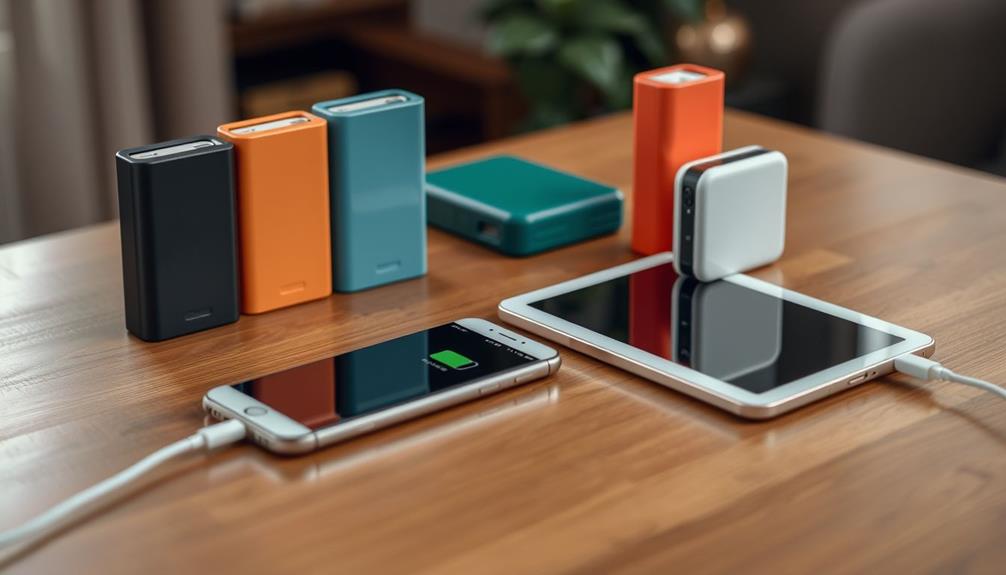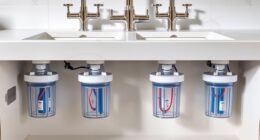To prepare for any disaster, focus on critical aspects like emergency planning, essential supplies, and shelter provisions. Guarantee a sufficient water supply and stockpile non-perishable food items. Create an emergency kit with necessary supplies like blankets, masks, and first aid materials. Develop a communication plan and review it regularly for thoroughness. Strengthen your home's security, learn basic survival skills, and stay informed through various channels like weather forecasts and local news. Remember, thorough planning and readiness form the foundation of effective disaster preparedness.
Key Takeaways
- Stock essential supplies like water and non-perishable food.
- Create a detailed emergency plan tailored to likely scenarios.
- Develop communication strategies and practice regularly.
- Learn basic survival skills such as first aid and navigation.
- Stay informed through weather forecasts and community alerts.
Importance of Being Prepared
Being prepared for any disaster is essential for your safety and well-being. Emergency preparedness is critical in ensuring that you're ready to face natural disasters effectively.
One key aspect of preparedness is securing an ample water supply. In times of crisis, access to clean water can be limited, making it important to store an adequate amount for drinking, cooking, and sanitation.
Natural disasters such as hurricanes, earthquakes, or floods can disrupt water sources, leading to shortages and contamination. By having a sufficient water supply stored in advance, you can guarantee that your basic needs are met even when utilities are unavailable.
Additionally, staying informed about potential risks in your area and creating a detailed emergency plan can greatly increase your chances of survival and reduce the impact of unforeseen events.
Essential Survival Supplies

Guarantee you have the essential survival supplies to stay safe and prepared in any disaster situation. In emergencies, access to clean water is vital. Make sure you have at least one gallon of water per person per day stored.
Non-perishable food items are also essential for your survival. Stock up on canned goods, dried fruits, nuts, and energy bars for sustenance during emergencies.
Additionally, having a well-equipped emergency kit can make a significant difference. Include items like a first aid kit, flashlight, batteries, multi-tool, and a whistle for signaling for help.
Proper food storage is imperative to avoid contamination and spoilage. Store your emergency food supplies in a cool, dry place away from direct sunlight. Regularly check expiration dates and rotate food items to maintain freshness.
Being prepared with these essential supplies can make a significant impact on your ability to withstand and recover from any disaster.
Emergency Shelter and Clothing

Make sure you have the necessary emergency shelter supplies and clothing to protect yourself and stay comfortable in any disaster scenario.
Emergency shelter supplies like a tent, tarp, sleeping bag, and portable stove are essential for guaranteeing warmth and protection in long-term emergency situations. Additionally, having a change of clothes, sturdy shoes, and personal hygiene items can greatly contribute to your comfort and well-being during a crisis.
Dust masks are vital for filtering contaminated air, while an emergency blanket provides insulation and protection in emergency scenarios. Whistles and flashlights with extra batteries can aid in signaling for help and providing illumination in dark or hazardous conditions.
Remember to pack prescription medications, cash in small denominations, and copies of personal documents in a waterproof bag to ensure preparedness for any disaster. These items, along with water storage and an emergency kit, are fundamental for your safety and security in challenging circumstances.
Readiness and Resilience

Preparing for any disaster requires a strategic approach to readiness and resilience.
You must verify that your essential supplies checklist is up to date, including food, water, medical supplies, and tools.
Developing an emergency communication plan is vital for staying connected with loved ones and authorities in times of crisis.
Essential Supplies Checklist
Including a variety of essential supplies in your preparedness kit is important for ensuring readiness and resilience in the face of any disaster. A well-rounded preparedness kit, as outlined in the Complete Guide, serves as your first line of defense when emergencies strike.
Items such as food, water, first aid supplies, shelter materials, and communication tools are highly valuable. Essential supplies like flashlights, multi-tools, tents, and emergency blankets are critical for disaster readiness, providing comfort and security.
Communication supplies, including radios, cell phones with chargers, and emergency contact lists, play a crucial role in staying connected during emergencies. Additionally, clothing, personal hygiene items, and prescription medications shouldn't be overlooked as they contribute to health maintenance and overall well-being.
Safety and protection supplies like matches, duct tape, work gloves, and emergency blankets help ensure safety and security in challenging situations. Be prepared by gathering these essential supplies to enhance your readiness and resilience in any disaster scenario.
Emergency Communication Plan
To guarantee readiness and resilience in any disaster scenario, establishing an emergency communication plan is paramount. One key aspect of this plan is designating an out-of-area contact person whom family members can check in with to coordinate and share information. Including crucial phone numbers, addresses, and meeting places in this plan ensures that everyone knows how to connect during a crisis. Rehearsing the communication plan through drills and ensuring that each family member has a copy of it significantly enhances readiness and resilience. Additionally, utilizing multiple communication methods such as text, social media, and walkie-talkies can increase the likelihood of successful communication during emergencies. Regularly updating and reviewing the emergency communication plan is crucial to keeping it relevant and effective for any disaster scenario.
| Emergency Communication Plan | Benefits |
|---|---|
| Designate out-of-area contact | Coordinate and share info |
| Include important contact info | Ensure connectivity in crisis |
| Rehearse plan through drills | Enhance readiness |
| Use multiple communication methods | Increase successful communication |
Planning for Self-Reliance

Creating a personalized emergency plan is essential for achieving self-reliance in preparing for disasters. When planning for self-reliance, consider the needs of all family members to guarantee everyone is taken care of during emergencies.
Identify the likely scenarios in your area and tailor your preparedness plan accordingly. Stock up on essential supplies such as food, water, first aid kits, and shelter materials to sustain yourself and your loved ones.
Develop communication strategies and maintain a list of emergency contacts to coordinate effectively in times of crisis. Regularly review and update your emergency plan to adapt to changing circumstances and remain prepared for any disaster that may strike.
Additionally, practicing survival skills like fire-starting, shelter-building, and navigation can enhance your self-reliance and readiness for unforeseen events. By taking these steps, you can increase your self-sufficiency and be better equipped to handle emergencies with confidence.
Building a Prepping Community

Connect with like-minded individuals in your area to begin building a prepping community. Forming a network of individuals who share your mindset towards preparedness is a well-thought step in enhancing your readiness for any disaster.
By collaborating with neighbors, friends, and family members, you can pool together resources, skills, and knowledge, ensuring that everyone is better prepared when emergencies strike. A prepping community not only offers practical assistance but also emotional support during crises, creating a sense of security within the group.
Organizing community events, drills, and meetings provides the opportunity to learn from one another and improve collective disaster preparedness. Taking the time to learn from each other's experiences and expertise can notably increase the effectiveness of your prepping efforts.
Together, you can strengthen your support network and work towards a more resilient community that's ready to face any challenge that may come your way.
Frequently Asked Questions
What Are the 5 Steps to Emergency Preparedness for Any Disaster?
To prepare for any disaster, you must follow five critical steps.
First, assess potential risks by identifying common threats in your area.
Second, create a family emergency plan with communication strategies and evacuation routes.
Third, build an emergency kit containing essential supplies like food and first aid items.
Fourth, stay informed by monitoring local news and weather alerts.
What Are the 10 Essential Survival Kit Items?
To be prepared for any disaster, your survival kit must include 10 essential items:
- Food
- Water
- First aid kit
- Flashlight with extra batteries
- Multi-tool
- Emergency shelter supplies like a tent or tarp
- Sleeping bag
- Portable stove
- Whistle
- Dust masks
Communication supplies such as a battery-powered radio, cell phone with charger, emergency contact list, paper, maps, clothing like a change of clothes, sturdy shoes, personal hygiene items, prescription medications, cash, safety and protection supplies like matches, duct tape, work gloves, emergency blanket, personal documents.
What Is the First Rule of Prepping?
The first rule of prepping is to prioritize health and financial readiness as the foundation for emergency preparedness.
Getting your home ready for two weeks of self-reliance is essential in following this rule.
Preppers emphasize focusing on personal well-being and home preparedness as initial disaster readiness steps.
Health, finances, and essential supplies for two weeks are core components of adhering to this rule.
Following it guarantees you're better equipped to handle any disaster effectively.
What Are 10 Items in an Emergency Kit for an Earthquake?
To prepare for an earthquake, your emergency kit should include:
- Non-perishable food and water
- First aid supplies
- Flashlights with extra batteries
- Tents and sleeping bags
- Portable stoves
- Battery-powered radios
- Cell phones with chargers
- Emergency contact lists
- Sturdy shoes and hygiene products
- Prescription medications
- Matches, duct tape, and work gloves
- Emergency blankets
These items guarantee you have sustenance, shelter, communication, clothing, and safety during and after an earthquake.
What Are the Essential Steps for Preparing for Any Disaster, According to Preppers?
Preppers believe in being prepared for any disaster. Essential steps include creating a family emergency plan, stocking up on food and water, securing a safe shelter, and learning how to protect home from potential threats. It’s important to stay informed and practice emergency drills regularly to ensure readiness.
Conclusion
In summary, being prepared for any disaster is vital for ensuring the safety and well-being of yourself and your loved ones.
By stocking up on essential survival supplies, creating a plan for self-reliance, and building a prepping community, you can increase your readiness and resilience in the face of unforeseen events.
Remember, taking the time to prepare now can make all the difference when disaster strikes.
Stay informed, stay safe, and stay ready.










